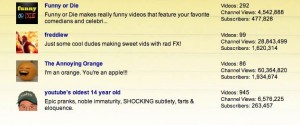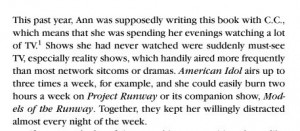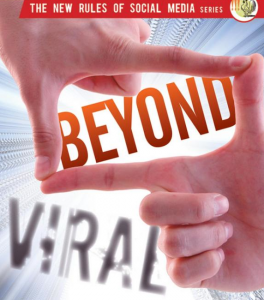In general, YouTube creators (and viewers) are a bit obsessed with sheer numbers of subscribers. It’s fool’s gold, friends. While early views are often predicated on developing a subscriber base, as a creator’s presence on YouTube matures, subscribers simply don’t matter nearly as much as people think. What matters is quality not quantity. I’d trade you half of my 250K subscribers for 1000 actively engaged viewers.
I say that to offset the prevailing belief that subscribers are everything, but recognize it’s a provocative overstament. A solid base of “fans” or avid viewers is invaluable. But after a while, the “subscription obsession” can be lazy and dangerous. Here’s why:
- There was a time where we thought most subscribers viewed videos, and in fact that was more true in 2008-2009. Today (with the exception of a dozen top channels), the majority of views by the top 500 YouTubers are driven by “related videos” and micro-featuring (spotlighted videos). Almost 80-90 percent of my daily views (ranging about 200-250,000 daily) are not from subscribers, and “search” drives only about 1 percent. Obviously a healthy subscriber base (especially those who interact with the video) has a cascading effect on related videos and microfeaturing. But…
- One loyal/active subscriber is worth more than 50 passive ones. Since only about 1 percent of viewers tend to interact with a video (and the creator’s relationship with his/her audience has a lot to do with that), the active viewer is GOLD. The passive troll (or dead account) is fool’s gold.
- Let me put this in simple terms. Of the quarter of a million views I get, perhaps ONE PERCENT of those are driven by subscribers deciding to check my latest video. That fact initially demotivated me and I shared that with YouTube staffers: why kill myself making new videos if it barely makes a difference to daily views, which sets my income? Lately, however, it makes me highly motivated to create more regular and better videos to maintain and grow a recurring audience. Sure- I feel fortunate that I have some momentum from the thousands of hours and thousands of videos I’ve created since 2004, but also very nervous about losing that momentum because of a simple shift in YouTube’s “programming” or algorithm.
- All subscribers are not created equally. Those who subscribe to my channel via “box-for-box” are often inadvertent viewers prone to leaving hate comments. As time goes on, you invariably increase the percentage of total subscribers who are not fans… they may find one video they like, subscribe, then complain or bail.
- I define the “health” of a YouTube channel as the recurring views that recent videos get. So while I’m happy to be getting millions of views a month, they are radically tilted toward old videos. My new videos get seen, with some exception, about 20K times… which is just 10% of my total subscribers (250K I think, but I’ve stopped checking).
- Even when I was about 100K subscribers and getting about 40-100K views per video, that was deceptive. First, a lot of those views came not from subscription but from the 10K plus people that would check my channel daily to see what’s new (that’s dropped). Also my recent videos were automatically adjacent to my legacy videos, which changed a few years ago. So what I saw as subscriber views were often driven by the dozen enduring videos (Scary Maze, Farting in Public). Now the videos that surround those are unlikely to be mine, thus the “binger” is less likely to get caught in a Nalts binge.

- Finally, I suspect that the increase in “trolls” on my Nalts channel may partially be the result of the kindness of BarelyPolitical to “box” me on its channel (this morning, I respectfully invited them to remove me from their “related channel” box). It drove high numbers of subscribers, but mostly people unfamiliar with me. For instance, my daughter posted a video last night (embarrassing brothers) and it fetched about 80 comments before day break… about 10 of them I needed to delete before she saw them. I expected the “get back to prank” comments, but the 10 were lude and clearly not people you want subbed. The video, which is consistant with what I’ve been making for 5 years, is simply not going to please a typical BarelyPolitical subscriber. The trolls come from a variety of sources, but when I see people refer to me as a third person I generally assume they didn’t subscribe with any premeditation.
So why is this important? It means independent creators are highly dependent on YouTube’s “programming,” which is currently an algorithm. If tomorrow YouTube made a change, my mature channel would evaporate instantly. These rules apply to all channels, but especially to those that have already built some momentum and wish to build on it…
The New Rules…
- Stop checking subscription numbers and focus on the quality of your relationship with fervent fans.
- Produce regular videos. I used to post daily, and when I stopped (on advice of many that said they’d prefer a good video weekly than decent videos daily) I lost a lot of momentum. Frequency is as important as quality. We are creatures of habit, and we’ll push that peddle over and over as long as a food pellet comes out (or to use gambling terms, we’ll keep playing the slots as long as we occasionally get a prize). But after a while, people stop checking your channel for new content. A month or two of zero or poor content can produce enduring damage… people simply forget to check your channel.
- Produce what Ryan Nugent at YouTube calls “Temporal Programming.” Produce content about current events, and plan content around major events… Shark Week is a nice example, and so are videos posted days before a big event (post your 4th of July video on July first so it builds steam).
- Third, BYOA. Bring your own audience. Annoying Orange drives a large chunk of his views from a very popular Facebook page. I’ve not had as much luck driving traffic via other mediums, but “seeding” is another way to garner views. Produce content that a popular blogger may enjoy and let him/her know about it. Look for other ways to syndicate your YouTube content beyond YouTube.
- Reconsider your “ask.” Should you ask for comments/ratings/favorites? Sure. That’s what makes a video jump on YouTube’s “most viewed” charts. But also consider other “asks” of your audience… subscribe via e-mail, check every Friday, etc.
The Onion used to publish online on Wednesdays, and I still wake up on Wednesdays and reflexively check (even though content is now regularly updated).
The bottom line is that audience development is about building yourself into the habit/routine of an active audience, not by getting a quantity of lukewarm viewers via a magical orange button.









